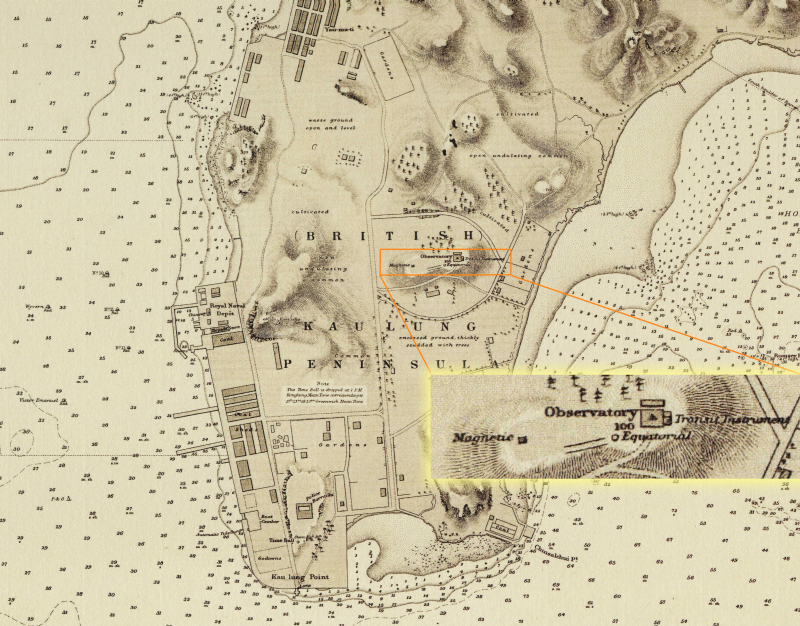
Category of Astronomical Heritage: tangible immovable
Meteorological Observatory, Hongkong, China

Description
Geographical position
Hong Kong (Meteorological) Observatory (founded in 1883), 134A Nathan Road, Tsim Sha Tsui, Kowloon, Hong Kong, China
- Jesuit Observatory, Shan-Liu-Road, Hongkong-Ting Kok Village, China (22°28’28.55’’ N, 114°13’12’’ E)
Location
22°18’09’’ N, 114°10’27’’ E, Elevation ....m above mean sea level.
IAU observatory code
D17
Description of (scientific/cultural/natural) heritage

Fig. 1. Hong Kong (Meteorological) Observatory (1883), (Wikipedia, CC3)
The idea of setting up a meteorological observatory in Hong Kong was first proposed by the Royal Society in 1879, especially <i>’favourably situated for the study of meteorology in general and typhoons in particular’</i>. The Hong Kong Observatory was established in 1883 on the Island by Sir George Bowen, the 9th Governor of Hong Kong, with William Doberck (1852--1941) as its first director.
Doberck had a conflict with the Jesuit fathers leading to the construction of other observatories in Asia; these Jesuits include Marc Dechevrens of the Shanghai Observatory and Federico Faura of the Manila Observatory.

Fig. 2. Hong Kong Observatory (1883) with Meridian Line, (HKO, 1951)
The Hong Kong Observatory, a rectangular two-storey plastered brick structure with arched windows and long verandas, was built in Tsim Sha Tsui (Observatory Road), Kowloon, in 1883. Next to the historical 1883 building; the "Centenary Building" was erected in 1983.
It was called Royal Observatory Hong Kong from 1912 to 1997 (date of transfer of Hong Kong’s sovereignty from the UK to China).
In addition to meteorological observations, also astronomical (for time service) and magnetic observations were made. Especially a tropical cyclone warning service was very important. The tropical cyclones were indicated by a typhoon gun already in 1884. This gun was placed in front of the Police Barracks at Tsim Sha Tsui facing Victoria Harbour.

Fig. 3. Nautical chart (1887) with Observatory in Kowloon (Transit Instrument, Equatorial, and Magnetic) and Victoria Harbour on the opposite site on the Island (HKO, credit Mr. Shun Chi-ming)
<h4>Time Keeping and Time Service in Hong Kong Observatory</h4>
In 1885, Hong Kong Observatory started the time keeping with a 6-inch-Refractor on a equatorial mount and a 3-inch-Transit Circle.
The time was announced to the mariners in the Victoria Harbour on the opposite site, but also to the general public, by dropping a 6-feet diameter Time Ball at 13:00 daily in front the Marine Police Headquarters Compound (1885). In 1908, the Time Ball was relocated to the hill of Blackhead Point due to a better visibility. The end of the time ball came in 1933, after radio broadcast and Radio Hong Kong since 1922 were available. In 1966, the pendulum clock was replaced by a crystal oscillator timing system, and the time was broadcasted with a 6-pip time signal on 95 MHz until 16 September 1989. In 1980, a Caesium beam atomic clock was introduced (accuracy less than 1 millisecond).

Fig. 4a. Time Ball in front of Marine Police Headquarters Compound in Kowloon (1885), (Wikipedia, Creative Commons)

Fig. 4b. Time Ball Tower, Blackhead Point (1908), (Wikipedia, Creative Commons)

Fig. 4c. Signal Tower (timekeeper), Blackhead Point (Wikipedia, CC 2.5, Clithering)
History

Fig. 5a. 3-inch-Transit Circle of Hong Kong Observatory (1883), (HKO, credit: CalaisAlumni)

Fig. 5b. Leroy 1350 Pendulum Clock (1924) of Hong Kong Observatory (1883), (HKO)
Instruments
- A 14-inch-Grubb telescope, made in the 1830s for Edward J. Cooper of Markree Castle, Co. Sligo, a respectable private observatory in 19th century Ireland, was sold to the Jesuit seminary in Hong Kong in the 1930s, and was destroyed in World War II. Only the 14-inch-lens of the Grubb telescope, made by Cauchoix survived in Manila.
- 6-inch-Refractor on a equatorial mount,
lost in WWII (removed by the Japanese) - 3-inch-Transit Circle, located right at the Hong Kong Meridian (Longitude 114°10’27.6’’ E),
lost in WWII (removed by the Japanese) - The two Meridian Marks (Northern and Southern) are preserved
- Meteorological Instruments
- Magnetic Instruments
- Leroy 1350 Pendulum Clock (1924)
- New Pendulum Clock (1950--1966), regulated by radio time signals after WWII (accuracy of a few seconds to one-fifth of a second)

Fig. 6a. Hong Kong Observatory (1983), (Wikipedia, CC2.5, Stewart)

Fig. 6b. Royal Hong Kong Observatory (1912 to 1997), (Wikipedia, CC4, Honeybee)
Directors
- 1883 to 1907 -- William Doberck -- 24 years
- 1907 to 1912 -- Frederick George Figg -- 4 years
- 1912 to 1932 -- Thomas Folkes Claxton -- 20 years
- 1932 to 1941 -- Charles William Jeffries -- 8 years
- 1941 to 1946 -- Benjamin Davis Evans -- 4 years,
director through Japanese occupation - 1946 to 1956 -- Graham Scudamore Percival Heywood -- 9 years
- 1956 to 1965 -- Ian Edward Meni Watts -- 9 years
- 1965 to 1981 -- Gordon John Bell -- 15 years
State of preservation
The Hong Kong Observatory building is a declared monument of Hong Kong since 1984.
Threats or potential threats
no threats
Present use
The Hong Kong Observatory is used as Meteorological Observatory.
Astronomical relevance today
No astronomical relevance today, but important in the field of meteorology and typhoon predictions.
References
Bibliography (books and published articles)
- MacKeown, P. Kevin: Early China Coast Meteorology: The Role of Hong Kong. Chapter 7: A Jesuit Conspiracy. Oxford Academic, HKU Press 2011.
- Udías, Agustín: "Jesuits’ Contribution to Meteorology." In: Bulletin of the American Meteorological Society 77 (October 1996), no. 10, 2307--2315.
- Udías, Agustin: Searching the Heavens and the Earth: The History of Jesuit Observatories. Dordrecht: Kluwer Academic 2013.
Links to external sites
- History of the Hong Kong Observatory
- Hong Kong Time (Wikipedia)
- Hong Kong Observatory - Hong Kong Meridian -- Hong Kong Meridian (YouTube)
- Hong Kong tropical cyclone warning signals (Wikipedia)
- Wah Yan College (Hong Kong) - Irish Jesuit Archives (Wikipedia)
- Wah Yan College, Hong Kong (1919), Irish Jesuits (Wikipedia)
- Wah Yan College, Kowloon (1924) (Wikipedia)
No multimedia content published
Currently there is no multimedia content published for this case study


















